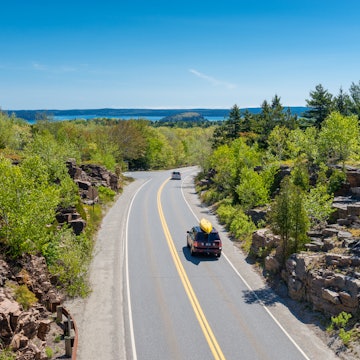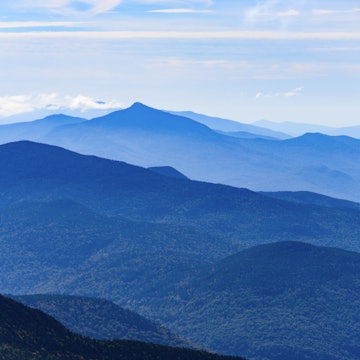
Want to catch the April 2024 eclipse in the USA? Here's how.

Feb 29, 2024 • 4 min read

The total solar eclipse on April 8, 2024 will cross a swath of US states. If you travel, be sure to bring your own glasses © Natalie Behring / Getty Images
Even as we travel around the globe, it’s easy to forget that our planet is part of a much larger celestial dance. Sure, we mark the orbit of the Earth around the Sun each year, but nothing reminds us that we are part of something much bigger than the experience of watching the Moon slide in front of the Sun during a solar eclipse.
This year a “total” eclipse – occurring on April 8, 2024 – will be visible across the entire USA, and the path of “totality” will pass across several major metropolitan areas. Some 31 million Americans live in that part of the country, and many millions more will travel to experience the eclipse.
How to plan to see the 2024 solar eclipse
There are several different types of eclipses, which happen whenever one celestial body passes in front of another. A solar eclipse occurs when the Moon passes in front of the Sun and casts its shadow over the Earth; when the Earth passes in front of the Sun and casts its shadow on the Moon, it’s a lunar eclipse. Eclipses differ depending on how much of the Moon or Earth obscures the Sun – and when the Moon completely blocks the sun, we have a total solar eclipse.
While the 2024 total solar eclipse will be at least partly visible across the Lower 48, we recommend staying in the path of “totality” – the dark shadow that passes over the Earth as the Moon completely blocks the Sun – for the most impressive experience. On April 8, the path of totality will run from southwest to northeast across the North American continent.
In the USA, the totality will be visible in parts of Texas, Oklahoma, Arkansas, Missouri, Kentucky, Illinois, Indiana, Michigan, Ohio, Pennsylvania, New York, New Hampshire, Vermont and Maine. Other parts of the USA will experience a partial solar eclipse, where only part of the Sun is blocked by the Moon.

What are the best places in the USA to view the 2024 eclipse?
There are some particularly notable spots along the line of totality – ones well worth planning a trip to.
National parks are generally great spots to experience the wonder of the outdoors – and there are several within the path of totality for the 2024 solar eclipse. Hot Springs National Park in Arkansas will be the first national park to experience this phenomenon; the surrounding community is already preparing for an influx of visitors that day. Cleveland’s Cuyahoga Valley National Park is another great spot to see the eclipse: it’s an urban park ideally placed near hotels and other amenities also in the path of totality.
Basing yourself in a major city is actually a great idea when planning an eclipse trip – and there are lots of them in the path of this one (in addition to Cleveland), including Dallas and Fort Worth, Indianapolis and Buffalo. These cities are easily accessible, with accommodations at all price points.
One last consideration in deciding where to view the 2024 solar eclipse is the weather: April 8 is still early in the spring season, and there’s a chance that those famed spring showers might bring cloudy skies. Viewing spots further to the southwest like Texas or Oklahoma have a higher likelihood of clear skies on the day of the eclipse.
What do I need to plan?
More than twice as many people live within easy travel distance of 2024’s path of totality, compared with the 2017 solar eclipse that cut across America. This means many more folks will be traveling to see the phenomenon – making early arrangements essential.
If you want to join a tour or some other eclipse-related experience, NationalEclipse.com is managing a database of eclipse happenings related to the 2024 event, though there will likely be many that aren’t listed there. So read up in advance on whatever might be happening at the viewing site you plan on traveling to.

What else do I need to know?
As you might expect, NASA is a big promoter of the 2024 eclipse (several NASA sites are even located along or near the path of totality). NASA’s “Where & When” page is very helpful in explaining the exact path as well as the science of eclipses. The site is especially useful if you’re planning to view the eclipse with younger astronomy fans.
Great American Eclipse is another great web resource. While it’s not managed by a professional astronomy organization, it’s a sort of eclipse fan page that first became popular during the 2017 eclipse. Today, it hosts many fascinating maps about this year's event and other future eclipses.
One last tip: snag your eclipse viewing glasses today. Back in 2017, viewers encountered a shortage of safe glasses in the weeks leading up to the event – so getting a pair or box now is the best way to ensure you don’t damage your eyes on the day of. Look for ones marked “ISO 12312-2,” which is the international code that says they protect your eyes from solar rays.
If you attend a viewing event, having a few extra pairs is also a great way to make friends and share in wonder of this special astronomical occurrence.















